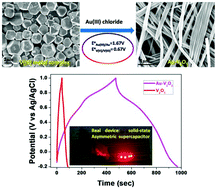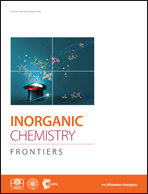Synthesis of Au-V2O5 composite nanowires through the shape transformation of a vanadium(iii) metal complex for high-performance solid-state supercapacitors†
Abstract
A simple redox transformation between a vanadium(III) metal complex and gold(III) chloride aided by a cost-effective modified hydrothermal procedure has been adopted for the synthesis of Au-V2O5 composite nanowires. The stability of pseudocapacitive electrode materials in acidic electrolytes is a major challenge. However, the synthesized Au-V2O5 composite nanowires are stable in acidic electrolyte when compared to the precursor component, V2O5. Electrochemical measurement shows a specific capacitance of 419 F g−1 at 1 A g−1 current density in 0.5 M H2SO4 solution for the synthesized composite nanowires. However, the precursor component V2O5 shows a lower specific capacitance under identical conditions. The synthesized composite nanowires, as a pseudocapacitive electrode material, respond to a wide range of working potential windows (+1.6 V), resulting in maximum energy and power densities of 53.33 W h kg−1 and 3.85 kW kg−1 respectively. Moreover, the Au-V2O5 nanowires show high cyclic stability (89% specific capacitance retention) for up to 5000 consecutive charge–discharge (CD) cycles at 10 A g−1 constant current density, due to the composite formation by redox transformation, which reflects the stability of the composite in acidic electrolyte.



 Please wait while we load your content...
Please wait while we load your content...